International SEO is the definitive approach to optimizing a website for ranking across various countries and languages in search engines. It’s about ensuring the right audience finds the right content, wherever they are in the world. However, an effective international SEO strategy goes beyond simple translation – it involves technical setup, localized content, and adherence to international SEO best practices like hreflang implementation and country targeting.
Why is international SEO important? Given that Google commands 92% of global traffic and performs over 8.5 billion searches every day, international SEO isn‘t just an option – it‘s a necessity for connecting with audiences globally. But international SEO doesn’t end up on Google; it also involves other search engines that are popular in specific countries. Regardless of a search engine type, international SEO works by signaling to search engines which regions and languages your pages serve, improving visibility and engagement in those areas.
This article offers a complete international SEO guide, covering key definitions and actionable international SEO tips to help you create a strategy that expands reach, boosts rankings, and drives meaningful results worldwide – read on and learn how to reach global audiences effectively!

What is International SEO in Google?
International SEO in Google is about making your website accessible, relevant, and visible to users worldwide. This is achieved by optimizing for different countries and languages through a blend of technical, content, and strategic adjustments. The ultimate aim is to ensure Google can effectively deliver the most appropriate version of your site to the right audience.
Google relies on several signals for international SEO, as follows:
- Hreflang tags,
- Geo-targeting settings in Google Search Console,
- Language-specific and region-specific URLs,
- Consistent regional content.
Addressing these factors can significantly enhance your global reach and ensure a seamless, relevant user experience across diverse linguistic and geographic boundaries. Read on to learn how to implement these strategies effectively and unlock the full potential of international online markets.
Speak to global audiences – create optimized, multilingual pages with Landingi now.
Why is International SEO Important?
International SEO is important because it enables expanding into global markets, increasing visibility in local search engines, enhancing user experience through language and cultural relevance, boosting conversion rates, and strengthening a brand’s authority in new regions. Additionally, without a proper international SEO strategy, search engines may misinterpret a site’s intended audience, leading to lower visibility and reduced traffic in international markets.
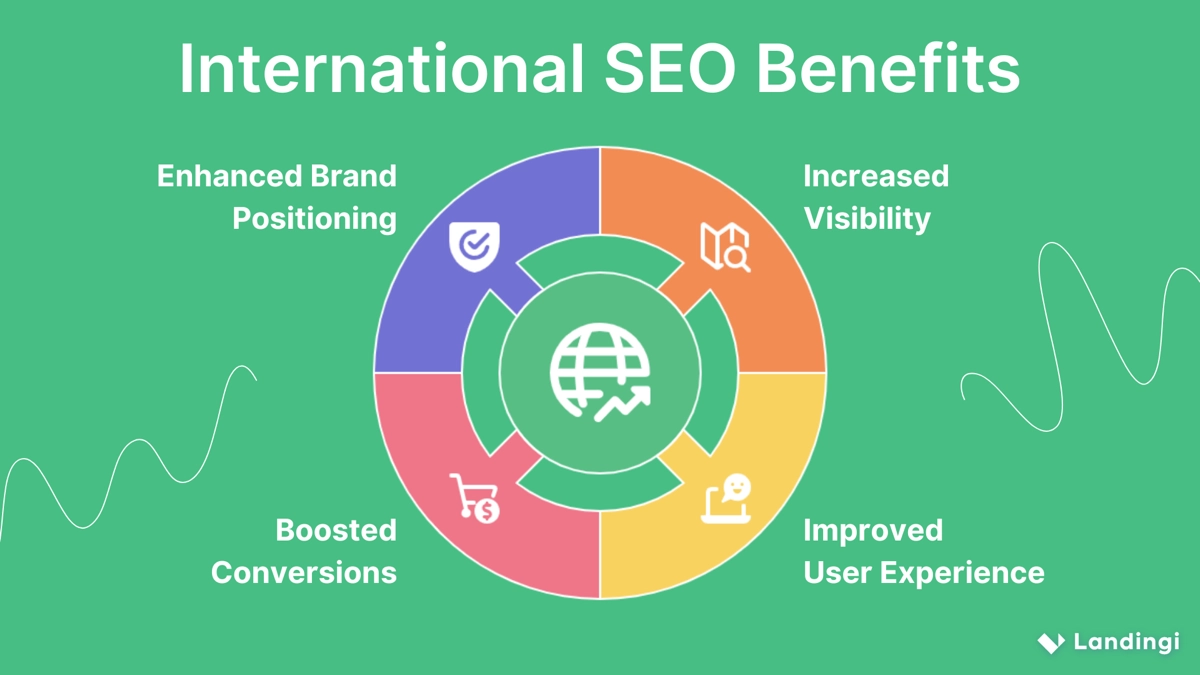
First, optimizing for local search signals, such as language, currency, and hreflang tags, you can improve rankings in local search results. Second, providing content in the user’s language and aligning it with regional preferences, such as preferred units of measure or relevant shipping information, can significantly reduce friction and boost user engagement.
Furthermore, creating localized content along with effective SEO strategies significantly boosts international conversion rates. The data from the “Can’t Read, Won’t Buy” study reveals that 40% of users are unlikely to purchase from websites in languages they don’t understand. Most crucially, in terms of SEO impact, international SEO helps refine global brand positioning and build domain authority in emerging markets. Google links region-specific relevance to site quality, enhancing the likelihood of ranking well for local search intent queries.
How to Create an International SEO Strategy?
To create an international SEO strategy, start by understanding international SEO basics and conducting thorough research to select regions and languages you should target, ensuring alignment with your business goals and audience needs. Identifying which markets offer the best opportunity and what search behaviors shape those markets is a foundation of each effective international SEO strategy. Then, combine technical SEO elements, localized content, and region–specific optimizations to help search engines deliver the right version of your site to the right users.
Check out all the essential steps to craft a strategy that ensures your brand reaches and resonates with global audiences:
1. Identify and Prioritize the Specific Regions or Languages You Aim to Reach
The first step is to analyze current international traffic to determine where demand exists and where your products or services fit local needs. To identify target markets, review your existing website analytics to see which countries already generate traffic, research competitors in those markets, and assess search volume trends using tools like Google Trends. It’s important to keep in mind that even countries that share the same language may require tailored approaches due to cultural, legal, or consumer preference differences. Therefore, making informed market selections is crucial for your success.
2. Research Keywords Specific to Your Target Locations and Languages
The second step is to pinpoint the specific terms that users in each target market are searching for. To achieve this, utilize tools like Google Keyword Planner to collect local search data. Pay attention to regional spellings, slang, and cultural nuances. This approach ensures that your international SEO strategies align with actual search behaviors, boosting your chances of ranking well and drawing in qualified traffic.
3. Choose the Right URL and Site Structure
The third step is to organize your website‘s content in a way that is clear and intuitive for both human users and search engine crawlers. This involves carefully selecting an appropriate URL structure that aligns with your business goals, target audience, and available technical resources. The three primary options for structuring international content are:
- Country Code Top-Level Domains (ccTLDs)
These are country-specific domain extensions like .de for Germany, .fr for France, or .co.uk for the United Kingdom. In fact, ccTLDs provide the strongest geographical signal to search engines, immediately indicating the target country, so this choice ensures higher trust and perceived relevance for local users, potentially boosting local search rankings. However, search engines treat each ccTLD as a separate website, meaning you’ll need to build separate domain authority and backlink profiles and often manage distinct SEO strategies for each. This can be significantly more expensive and resource-intensive to set up and maintain, especially if you’re targeting many countries. - Subdomains
This structure uses a prefix before your main domain, such as uk.example.com or fr.example.com. Subdomains provide greater flexibility than country code top-level domains (ccTLDs) and are usually easier and more affordable to establish and manage. They enable you to create distinct content and SEO strategies tailored to specific regions or languages, all while remaining connected to your main brand. Anyway, even though Google understands the relationship between subdomains and the root domain, they are often treated as distinct entities. It means they may not fully benefit from the SEO authority of the main domain. As a result, it can be more challenging for new subdomains to achieve quick rankings compared to subdirectories. - Subdirectories
Subdirectories serve as folders within your main domain, such as example.com/uk/ or example.com/fr/. They are often seen as the most practical and SEO–friendly solution for businesses, as they take advantage of your main site’s existing domain authority. This approach not only streamlines your SEO efforts but also allows backlinks to enhance your entire international presence. Implementing and managing subdirectories is comparatively straightforward, making them highly scalable for incorporating new regions or languages. While this solution has its drawbacks, such as potentially lacking the robust geo-targeting strength of ccTLDs, these issues can be addressed by effectively implementing hreflang tags and appropriate settings in Google Search Console.
Choosing the proper structure for your site is vital because it influences how search engines perceive your intended audience. By selecting the most appropriate structure, you signal clear geographic or language preferences, which aids search engines in crawling, indexing, and ranking the appropriate versions of your content for users in each international market.
4. Localize Content Beyond Translation
The fourth step is to localize content by adapting it to the local language, cultural nuances, currency, and legal requirements of each market. A robust international SEO strategy goes beyond simply translating words – it ensures the content resonates with the target audience in different languages, reflecting their expectations and local context. The best option to achieve this level of localization is to work with native experts who understand the region’s specifics and can adjust messaging, offers, and visuals accordingly. However, there are also some tools, such as Localise or Phrase, that can help you automate content localization efforts.
Expand your reach, increase your conversions! Build global-ready landing pages with Landingi.
5. Implement Technical SEO for International Sites
The fifth step is to ensure search engines correctly index and serve the right versions of your pages. To achieve this, you must focus on technical SEO – apply hreflang and canonical tags to signal language and regional targeting, maintain clean site architecture across multiple websites if used, and optimize internal links so users and crawlers can easily navigate between regional versions.
5 Proven International SEO Tips and Best Practices
Beyond the basics described above, you should also consider international SEO best practices, involving thorough market research, optimization for local search engines, choosing fast servers to host language versions, building local backlinks, and providing clear language and region options. These proven methods help websites targeting multiple languages strengthen their rankings, improve user experience, and gain a competitive edge in international markets.
Check out the key tips every global strategy should follow to achieve lasting SEO success:
1. Analyze Different Regional Markets
The foundational step in any successful international SEO strategy is to conduct thorough market research for different regions. International SEO is far more structured than simply choosing a few languages to translate your content. It requires a deep understanding of the unique landscape of each potential local market. You should analyze demographic data, economic indicators, and internet penetration rates to assess the viability and potential return on investment for each country or language group you’re considering.
Beyond general market insights, it’s crucial to conduct competitor research specific to each targeted region. For this purpose, you can leverage competitor analysis tools, like those provided by Ahrefs or Semrush. There are 3 key questions whose answers can help you uncover opportunities and identify potential challenges, ultimately guiding you to refine your approach:
- Who are the dominant players in that area?
- What are their strengths and weaknesses?
- How do they approach their online presence, content, and local SEO?
Example:
For instance, you can utilize Semrush to identify keyword gaps and enhance your local content strategy based on these findings. The Keyword Gap tool is user-friendly – simply enter your domain along with a few of your key competitors, and apply the Missing filter to discover keywords that your rivals are ranking for but you aren’t. This tool is invaluable when you aim to broaden your reach and improve your local SEO efforts.
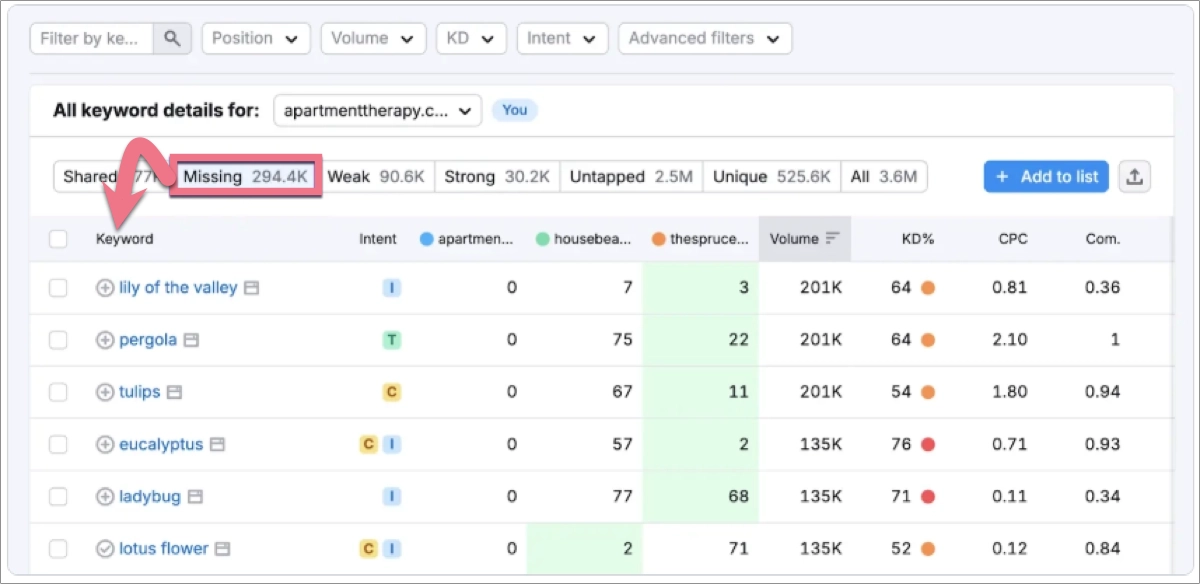
Furthermore, undertake comprehensive international market research to identify search trends, popular search engines (Google isn’t always king everywhere!), and user behavior nuances. For instance, payment preferences, cultural sensitivities, and preferred communication styles can vary wildly from one country to another. Understanding these elements will inform not only your SEO tactics but also your overall marketing and user experience design for that specific locale. This initial investment in robust research provides the critical insights needed to tailor your efforts effectively and avoid costly missteps down the line.
2. Optimize for Local Search Engines
While Google dominates in many parts of the world, relying solely on it can significantly limit your reach. Different countries have their own preferred search engines where users conduct searches and expect to find relevant keywords in their native language and context. For example, Baidu is popular in China, and Naver has a significant influence in South Korea.
Your international SEO efforts must extend beyond just Google to encompass these local powerhouses, so you should understand these search engines‘ unique ranking algorithms, indexing processes, and user interfaces. Each local search engine may prioritize different factors, such as local citations, unique content formats, or specific technical requirements. You’ll need to adapt your keyword strategy, content creation, and even technical SEO to align with what these engines favor.
Example:
For instance, when you want to optimize your website for Baidu, you must know the basics – this search engine favors websites that are hosted on servers in China and only indexes simplified Chinese characters. Additionally, Baidu rather ignores keywords in the URLs, and, what can be surprising, but places significant emphasis on meta descriptions and meta keywords, unlike Google, and prefers frequent content updates to maintain ranking.

3. Use Fast Servers for All Language Versions
The geographical location and responsiveness of your server directly impact website loading speeds, which are critical factors for both user experience and search engine rankings. Slow-loading pages can lead to high bounce rates, as impatient website visitors will likely abandon a site if it takes too long to load.
To ensure optimal performance for your international audience, consider using Content Delivery Networks (CDNs). A CDN stores cached versions of your website’s content on multiple servers worldwide. When a user accesses your site, the CDN delivers the content from the server geographically closest to them. This significantly reduces latency and speeds up page loading times, regardless of where your visitors are located.
Conquer new markets! Use Landingi to create optimized pages tailored to international audiences.
Example:
Imagine you have created Spanish and Japanese versions of your website, which is an addition to your main English site hosted on a server in the U.S. If all the language versions are on the same server, users in Japan may find it difficult to access the Japanese version smoothly. To avoid this, it’s wise to use a Content Delivery Network (CDN) like Cloudflare. A CDN keeps copies of your site on servers around the globe, allowing users in Spain to quickly load the Spanish version from a server in Europe, while those in Japan can access the Japanese version from a server in Asia. This setup ensures that all language versions load quickly for their respective audiences, enhancing user experience and boosting search rankings worldwide.
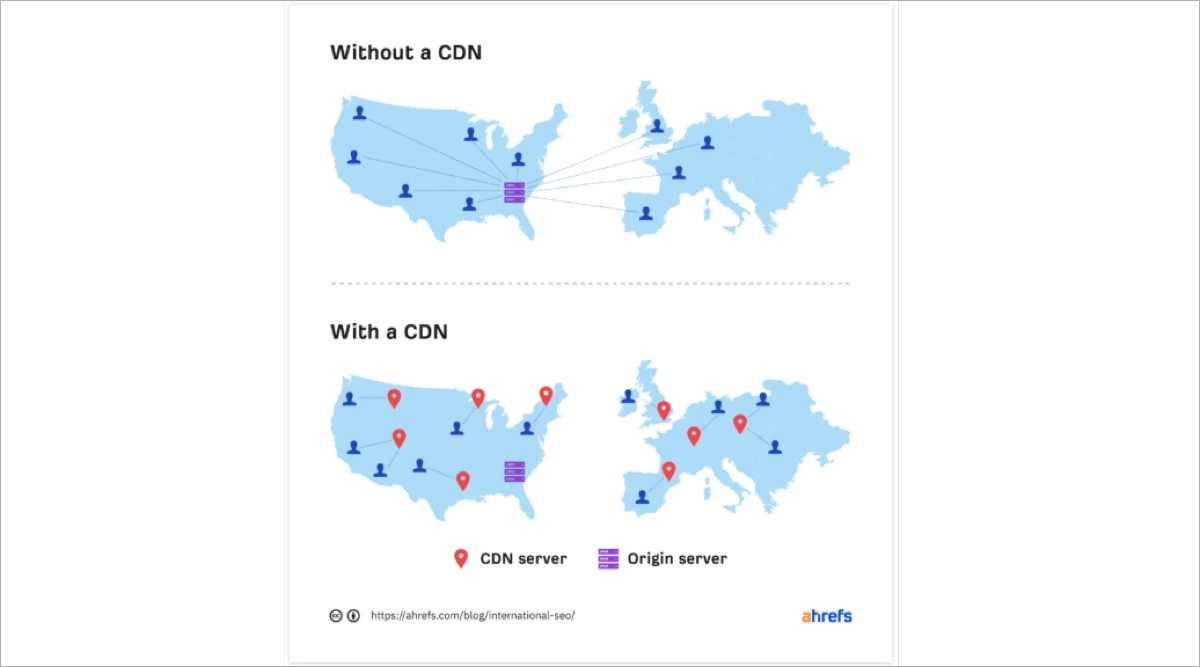
4. Build Local Backlinks and Citations
A strong international SEO strategy requires a focus on building local backlinks and citations. Just as with domestic SEO, high-quality backlinks from authoritative and relevant local websites signal trustworthiness and authority to search engines. However, for international SEO, the emphasis shifts to acquiring links from sites within your specific target regions.
Move beyond general link-building tactics and actively seek opportunities within each local market. For instance, if you’re targeting Germany, focus on acquiring links from German business directories, local news outlets, industry-specific German blogs, or partnerships with German companies. These geographically relevant links are far more impactful for local search rankings than generic international links.
Example:
There are multiple ways to earn local backlinks, from offering local resources to covering local topics on blogs, but one proven method is to use a dedicated tool to check out your competitors’ backlinks and uncover new backlink opportunities. You can, for instance, use Ubersuggest – just enter your competitor’s domain and go to the Backlinks Overview report to see the full list of its backlinks. It reveals new opportunities for building backlinks to your own website.
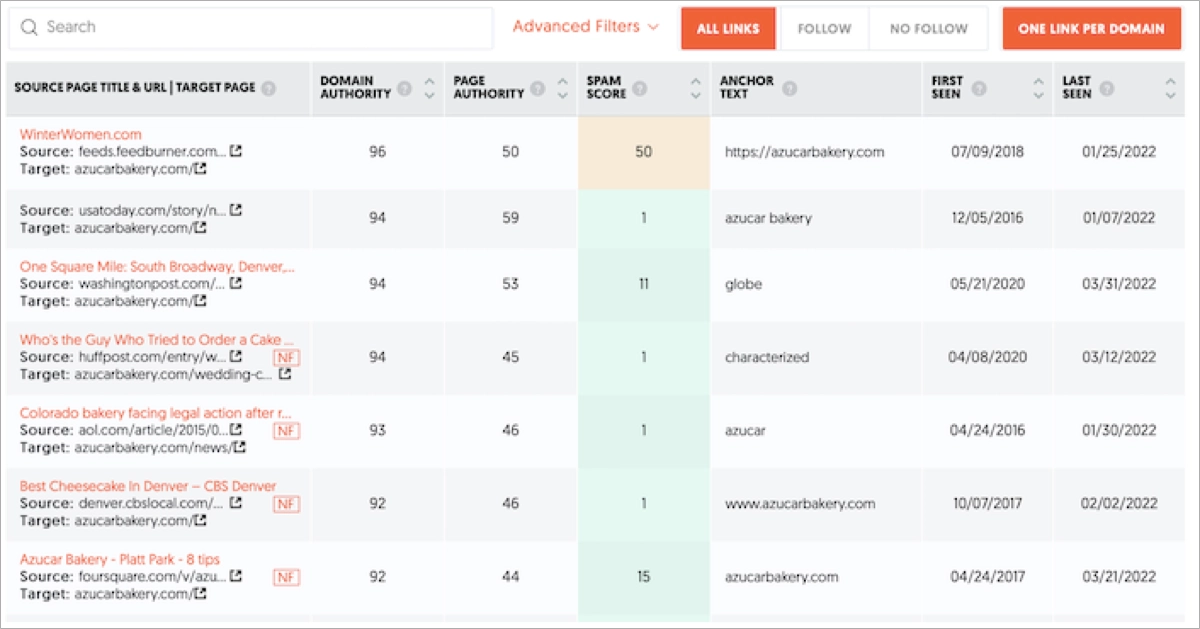
Citations are also essential for your business, especially for local searches, so ensure your business is listed correctly and consistently in your area‘s local directories, review sites, and online maps. Consider using Google My Business and local services like Baidu Maps in China. This local validation is crucial for improving your visibility in “near me” searches and for ranking higher in local search results, directly impacting your ability to attract and convert customers in those international markets.
5. Offer Clear Language and Region Options
A common but often detrimental practice in international SEO is automatically redirecting users based on their IP address or browser cookie settings. While seemingly helpful for directing users to their “local” version of a site, this approach can severely harm your international SEO efforts and user experience.
Instead of automatic redirects, implement clear and user–friendly options for language and region selection. A prominent, visible language switcher (e.g., in the header or footer) allows users to select their preferred version manually. You can also subtly suggest a version based on IP or browser settings, but always provide an easy way for the user to override this suggestion and choose another option. This approach prioritizes user choice and ensures that search engines can access and index all of your valuable localized content.
Example:
A good example of well-implemented language and region selection is GetResponse’s website – they have placed an intuitive language switcher in the footer, so each website visitor has full control over choosing the preferred language version.
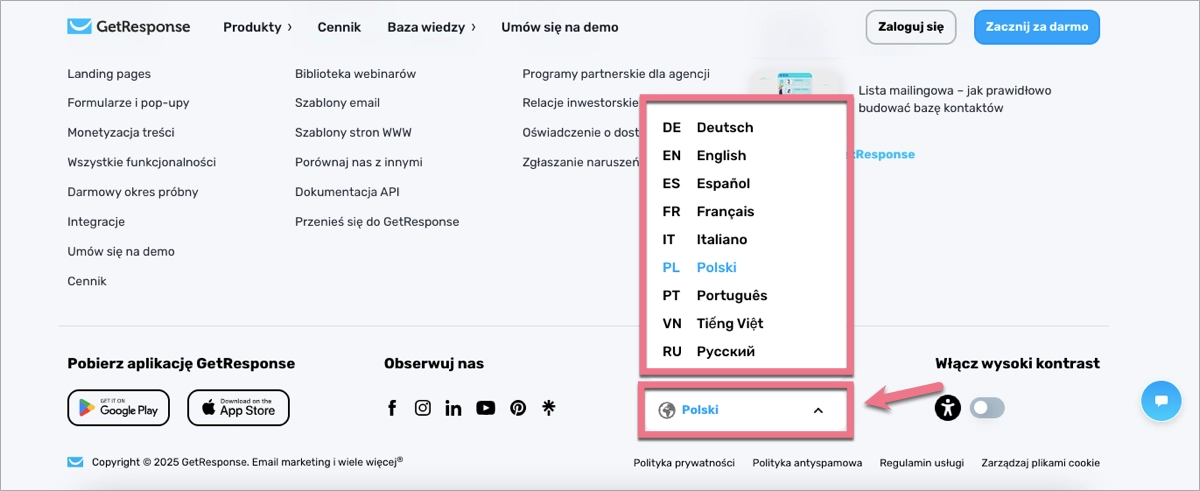
Some websites, like Hostinger (which optimizes its website for multiregional and multilingual international SEO), provide more advanced options. Its language choice options distinguish various regions, even though some of them use the same language, and conversely, it also enables the choice between various languages for multilingual regions.
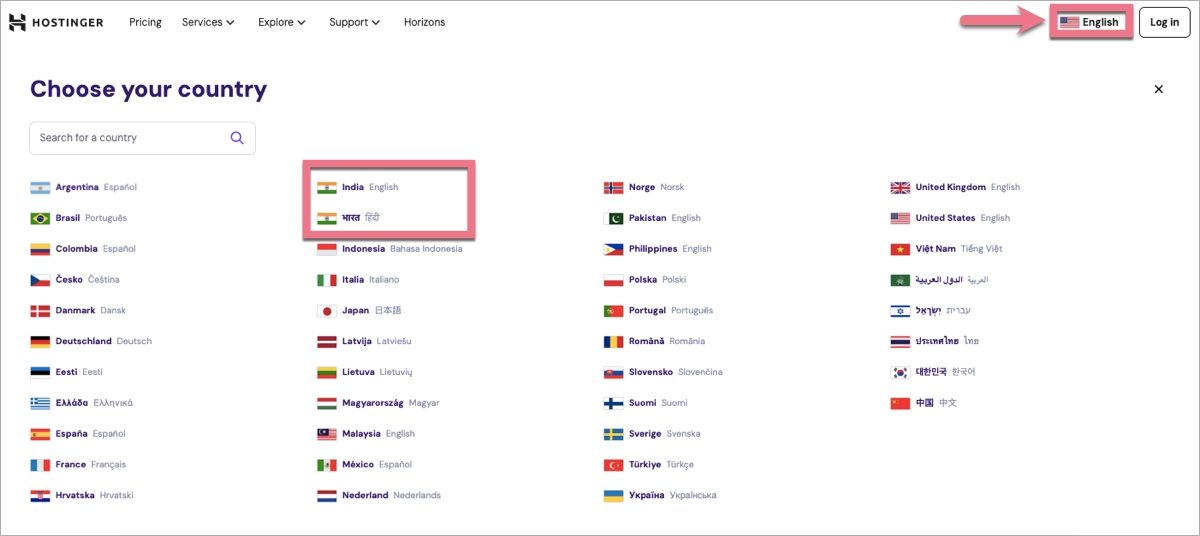
What Is International SEO vs. Local SEO?
The main difference between international and local SEO is that international SEO aims to expand a website’s reach across multiple countries and languages, while local SEO focuses on improving a business’s visibility within a specific geographical area. Therefore, international SEO targets multiple countries and languages, using hreflang tags and regional content, and local SEO is more focused on a specific city or region, optimizing for map results and local queries.
Both aim to improve rankings, but their goals, methods, and scale differ. The key differences between those two types of SEO involve:
- Target area, where international SEO aims at multiple countries or languages, and local SEO focuses on one city or region,
- Search engine signals, where international SEO uses hreflang, geo-targeting, and localized content, and local SEO uses proximity, local citations, Google Maps listings, and NAP (Name, Address, Phone) consistency.
- Tools and platforms, where for international SEO, hreflang validators, CDN settings, and language-specific keyword research matter most, and for local SEO, Google Business Profile is crucial.
- Content Strategy, where international SEO requires translation and localization, and local SEO emphasizes location-specific pages and local relevance.
Rank globally, convert locally! Build high-impact international landing pages with Landingi.
What Is the Difference Between Multilingual and Multiregional International SEO?
The main difference between multilingual and multiregional international SEO lies in targeting –multilingual international SEO targets users who speak different languages, while multiregional SEO focuses on specific countries or regions, even if they share the same language.
Therefore, multilingual international SEO is about optimizing website content in multiple languages, regardless of geographic location. Offering English, Spanish, and French versions ensures users can access content in their preferred language, even if they live in the same country or across borders.
In contrast, multiregional international SEO involves creating country-specific content variations (like pricing, legal info, or offers) and signaling them to search engines. For instance, separate pages can be created for the U.S., UK, and Australia – all in English but tailored to each market.
Where to Find the International SEO Checklist?
You can find an international SEO checklist on industry blogs, where experts frequently share their knowledge and best practices – leading SEO and digital marketing websites, such as Moz, Semrush, Search Engine Journal, and Ahrefs, are excellent resources. These platforms regularly publish in-depth guides and checklists that break down the complex process of international SEO into actionable steps.
For instance, Ahrefs offers a downloadable international SEO checklist covering key steps such as choosing the proper URL structure or conducting keyword research for each market – it’s an excellent resource for everyone, whether you’re a beginner eager to grasp the fundamentals or a professional in search of a well-organized approach.
What Are the Best International SEO Tools?
Among the best international SEO tools, Ahrefs, Semrush, and Google Search Console are widely recommended for their robust features and global optimization capabilities. These tools help analyze international traffic, track rankings, optimize hreflang, and research local keywords, making them essential for effective international SEO strategies.
Ahrefs
Ahrefs is widely regarded as a leading tool for international SEO, primarily due to its comprehensive global data. It offers invaluable insights into various markets, which are essential for optimizing global websites and achieving international SEO success. The platform’s extensive keyword and backlink data are crucial in navigating different search landscapes and enhancing visibility across diverse regions worldwide. Ahrefs offers a plan for small businesses that costs $129 per month, but if you need more advanced features, you can subscribe to the Standard plan for $249 per month.

Semrush
Semrush is another valuable tool for international SEO, particularly for tracking rankings and optimizing content for multiple markets. It offers advanced features, such as hreflang validation tools, local keyword research, and competitive analysis. While Ahrefs is highly regarded for its raw backlink data and estimations of actual clicks, Semrush provides a broader array of keyword and market insights, including PPC data. This platform offers a free trial. However, full access to SEO plans requires a subscription (ca. $250 monthly for small businesses).

Google Search Console
Google Search Console is undoubtedly best for monitoring international websites’ SEO performance directly in Google, the most popular search engine. It offers insights into indexing, hreflang implementation, and country targeting. This direct connection to Google’s data is invaluable for understanding how your content is perceived globally and troubleshooting any region-specific issues. It’s a free, essential tool for any website aiming for international organic visibility.
| Ahrefs | Semrush | Google Search Console | |
|---|---|---|---|
| Main Strength | Backlink analysis & competitor data | Keyword research & site audits | Monitoring site performance in Google |
| Best For | Global backlink strategy | Managing multiple sites & local SEO | Checking indexing, hreflang, and targeting |
| Keyword Tools | Strong, with global databases | Extensive, with local keyword tools | Limited, focused on Google queries |
| Hreflang Support | Partial (via site audit) | Yes, with dedicated hreflang reports | Yes, with Google’s direct checks |
| Search Engine Focus | All major search engines | All major search engines | Google only |
| Pricing | Paid, premium plans | Free trial, paid plans | Free |
What’s the Role of the Landing Page in International SEO?
Landing pages are crucial for international SEO as they offer highly customized experiences for a global audience. They provide localized versions of your content tailored for specific countries, languages, and cultural nuances. This localization helps search engines accurately identify the target market for each page, boosting rankings not just on Google but also on other search engines that are popular in various regions. Ultimately, these targeted pages lead to higher conversion rates by directly meeting the needs and preferences of visitors from specific regions.
Therefore, to achieve international SEO success – reach and convert a global audience, you need localized landing pages, and the best platform for their effortless creation is Landingi. Beyond basics, such as a robust template gallery with over 400 pre-designed pages, a drag-and-drop builder, and built-in A/B testing, the platform offers advanced tools that streamline creating multi-language pages.

Its automatic translation tool supports over 29 languages, allowing you to instantly adapt your content for diverse markets without manual translation headaches. This means you can launch campaigns in multiple languages simultaneously, reaching new audiences faster and more efficiently. The platform also facilitates dynamic text replacement, enabling you to personalize content based on user location or preferences, further enhancing relevance and conversion for your global visitors. If you’re looking for a comprehensive, user-friendly solution to conquer international markets with highly optimized and localized landing pages, Landingi is undeniably the tool you need to scale your global SEO efforts and drive tangible results.
Multilingual SEO + Landingi = global growth. Start building optimized pages today!
How Much Does International SEO Cost?
International SEO services offered by specialized agencies usually range in cost from $3,000 to $10,000 per month. The main factors that affect prices include the scope of the project, its complexity, required services, and the agency’s expertise.
Hiring an international SEO consultant costs from $50 to $200 per hour, and project-based fees range from a few thousand to even tens of thousands. Considering other SEO services, like one-time site audits, technical overhauls, or multilingual keyword research, usually range from $1,000 to $50,000, depending on scope and deliverables.
Even though international SEO services seem quite expensive, the structured approach and professional guidance can help you achieve global success, resulting in significant ROI (Return on Investment) through increased organic traffic, higher conversion rates, and expanded market share – think twice, but it’s worth it!
What Are the Limitations of International SEO?
International SEO has several limitations that businesses must address, which include managing multiple regional sites, handling cultural differences, facing limited market share, and dealing with incomplete keyword data. First, managing multiple sites or regional sites increases technical demands, maintenance, and costs.
Second, cultural differences require more than translation – they demand localized content that resonates with local audiences. Such efforts often require higher budgets, whether for skilled professionals or advanced tools. Furthermore, in smaller markets, a low market share may limit the return on SEO investments. Additionally, incomplete or inconsistent keyword data for specific regions complicates keyword research, making it harder to align SEO strategies precisely with local search behavior and preferences. However, the potential for massive growth, diversified revenue streams, and enhanced brand authority in untapped global markets often outweighs these challenges for businesses willing to invest strategically.
Use International SEO to Boost Traffic on Your Landing Pages
International SEO is a powerful strategy to expand your reach and connect with users across regions and languages. By improving language targeting and optimizing for local search behavior, you ensure your content speaks directly to each audience. Ultimately, strong international SEO performance increases visibility, drives qualified traffic, and strengthens brand authority in diverse markets – it’s all you need to ensure long-term global success for your business.
Remember, for businesses managing multilingual websites, the payoff comes from precision – aligning technical setup, content, and optimization efforts to deliver the right experience in every location. Take advantage of this international SEO guide and combine it with proven international SEO tips to avoid common pitfalls, stay ahead of algorithm updates, and maximize results. With careful strategy and ongoing refinement, international SEO becomes not just a marketing tool but a growth engine.
To achieve the most and turn your plan into real success, try Landingi, create multi-language pages, and implement international SEO best practices – expand your reach and conquer new global markets with confidence!






